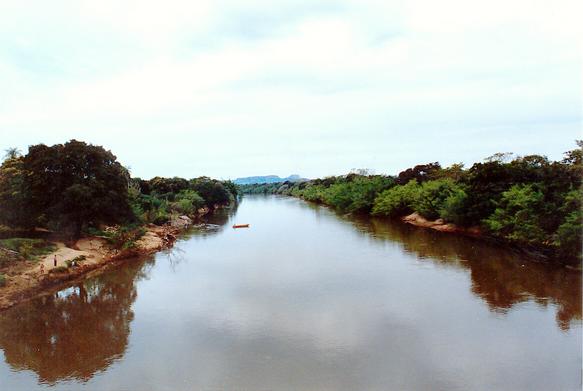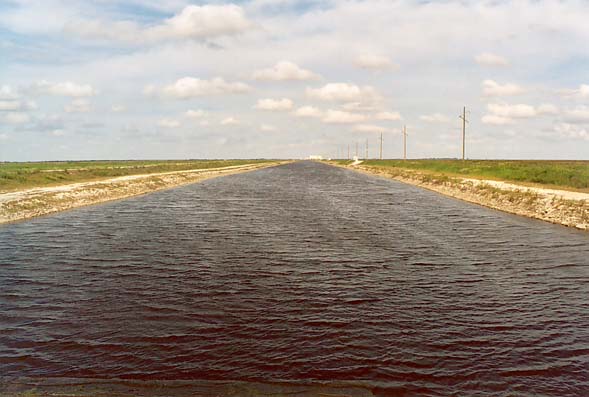UNSTEADY FLOW WITH HEC-RAS
1. HEC-RAS
1.1
The U.S. Army Corps of Engineers Hydrologic Engineering Center River Analysis System, for short, the HEC-RAS model,
can perform three types of calculations: (1) steady flow, (2) unsteady flow, and (3) movable boundary flow.
1.2
The steady flow component uses the standard step method for the solution of steady gradually varied flow.
 Mississippi river, near Bemidji, Minnesota.
Mississippi river, near Bemidji, Minnesota.
1.3
The unsteady flow component uses a numerical solution of the complete equations of gradually varied unsteady flow, commonly referred to as the dynamic wave.
 Chane river at flood stage, Santa Cruz, Bolivia.
Chane river at flood stage, Santa Cruz, Bolivia.
1.4
The movable boundary component uses the sediment continuity and one of several sediment transport equations to calculate river bed aggradation and/or degradation.
2. WHEN IS IT NECESSARY TO USE UNSTEADY FLOW?
2.1
This question is of considerable practical interest, since unsteady flow is significantly more complex and requires more data than steady flow.
 Chane river at flood stage, Santa Cruz, Bolivia.
Chane river at flood stage, Santa Cruz, Bolivia.
2.2
However, the answer is not straightforward, requiring some elaboration.
3. STEADY VS UNSTEADY FLOW
3.1
Under steady flow, the user specifies discharge at the upstream boundary and stage at the downstream boundary.
 Steady flow.
Steady flow.
3.2
The steady flow model proceeds to calculate stages throughout the interior points, while keeping the discharge constant.
3.3
Under unsteady flow, the user specifies a discharge hydrograph at the upstream boundary and a discharge-stage rating at the downstream boundary.
 Unsteady flow.
Unsteady flow.
3.4
The model proceeds to calculate discharges and stages throughout the interior points.
3.5
Under steady flow, the discharge-stage ratings are unique, that is, they are the same as in unsteady kinematic flow.
3.6
Under unsteady dynamic flow, the model calculates looped discharge-stage ratings according to the variability of the flow.
3.7
Therefore, the specification of a unique, that is, kinematic, discharge-stage rating at the downstream boundary contradicts the solution at that boundary.
3.8
Simply stated, the wave cannot be kinematic at the downstream boundary and dynamic everywhere else!
 Aquidauana river, Mato Grosso, Brazil.
Aquidauana river, Mato Grosso, Brazil.
3.9
A way out of this difficulty is:
(1) to artificially move the downstream boundary further downstream,
(2) to specify the unique discharge-stage rating at the new, artificial downstream boundary, and
(3) to let the model calculate the looped ratings at all interior points, real and artificial, including the point where the actual physical downstream boundary is located.
 Unsteady dynamic flow.
Unsteady dynamic flow.
3.10
Despite its apparent artificiality, this procedure works well and circumvents the need to know the discharge-stage rating at the downstream boundary before it is calculated.
 California Aqueduct.
California Aqueduct.
4. KINEMATIC VS DYNAMIC WAVES
4.1
The decision to use or not to use unsteady flow in HEC-RAS will depend on whether the wave being analyzed is either kinematic or dynamic.
4.2
If the wave is kinematic:
(1) the discharge will not vary in time;
(2) the discharge-stage ratings will be unique; and
(3) the downstream boundary condition may be specified as a unique rating.

Kinematic wave.
4.3
In this case, the solutions of steady and unsteady flow are essentially the same; therefore, the unsteady flow calculation is not needed.
 Wellton-Mohawk canal, near Wellton, Arizona.
Wellton-Mohawk canal, near Wellton, Arizona.
4.4
If the wave is dynamic:
(1) the discharge will vary in time and space, attenuating as it moves downstream;
(2) the calculated discharge-stage ratings will not be unique; and
(3) for better accuracy, the downstream boundary may be moved downstream artificially to allow for a looped rating to develop at the actual physical downstream boundary.

Dynamic wave.
4.5
In this case, the unsteady flow calculation is justified, assuming of course, that the wave is really dynamic.
 Chane river at flood stage, Santa Cruz, Bolivia.
Chane river at flood stage, Santa Cruz, Bolivia.
5. KINEMATIC VS DYNAMIC WAVES
5.1
The preceding considerations beg the question of whether a given flood wave can be construed as either kinematic or dynamic.
5.2
Or, better yet, whether a dynamic wave should be used at all to determine stages in the design of channel improvement projects.
5.3
On typical projects, of limited channel lengths, a kinematic wave, which keeps its discharge constant, is a more appropriate assumption than a dynamic wave, which attenuates its discharge.
 G-370 canal, South Florida.
G-370 canal, South Florida.
5.4
Indeed, the kinematic wave assumption assures that the channel is designed to contain all waves, kinematic or dynamic.
5.5
The stages calculated with the kinematic wave assumption are essentially the same as those calculated using steady gradually varied flow.
5.6
Therefore, the use of the unsteady flow feature of HEC-RAS for the calculation of stages in the design of channel improvements projects does not appear to be warranted.

Chane river at flood stage, Santa Cruz, Bolivia.

Chane river at flood stage, Santa Cruz, Bolivia.

Apa river, border between Brazil and Paraguay.

Chane river at flood stage, Santa Cruz, Bolivia.

G-370 canal, South Florida.

Bombuscaro river, Podocarpus National Park, Zamora-Chinchipe, Ecuador.

California Aqueduct.

Mississippi river near Bemidji, Minnesota.

Aquidauana river, near Aquidauana, Mato Grosso, Brazil.

Wellton-Mohawk canal, near Wellton, Arizona.

Steady flow.

Unsteady flow.

Unsteady dynamic flow.

Kinematic wave.

Dynamic wave.
Narrator: Victor M. Ponce
Music: Fernando Oñate
Editor: Aleksandr Gostomelskiy
Copyright © 2010
Visualab Productions
All rights reserved
 Mississippi river, near Bemidji, Minnesota.
Mississippi river, near Bemidji, Minnesota.
 Chane river at flood stage, Santa Cruz, Bolivia.
Chane river at flood stage, Santa Cruz, Bolivia.
 Chane river at flood stage, Santa Cruz, Bolivia.
Chane river at flood stage, Santa Cruz, Bolivia.
 Steady flow.
Steady flow.
 Unsteady flow.
Unsteady flow.
 Aquidauana river, Mato Grosso, Brazil.
Aquidauana river, Mato Grosso, Brazil.
 Unsteady dynamic flow.
Unsteady dynamic flow.
 California Aqueduct.
California Aqueduct.

 Wellton-Mohawk canal, near Wellton, Arizona.
Wellton-Mohawk canal, near Wellton, Arizona.

 Chane river at flood stage, Santa Cruz, Bolivia.
Chane river at flood stage, Santa Cruz, Bolivia.
 G-370 canal, South Florida.
G-370 canal, South Florida.

